Get Your Sub Singing!
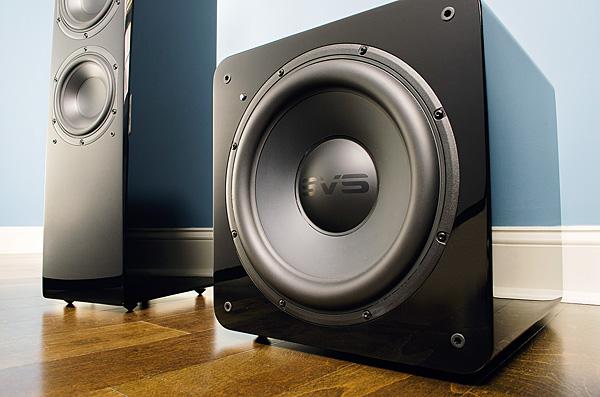
Is it my imagination or has the subwoofer faded from audiophile affections? In the 1990s a generation of audio lovers discovered that subwoofers could do unexpected things: not just add low-bass heft, but also improve midrange sound quality and the spaciousness of the stereo image.
Today it feels as if these benefits have been forgotten and the subwoofer side-lined – which is odd given that digital audio continues to deliver bass of extension and quality unknown to LP or even analogue master tape, while the quest to design more sensitive speakers has left many lacking in the lower octave or more of the audible spectrum.
Where Oh Where?
Maybe you never lost faith and still use a subwoofer. Maybe you have a once-loved subwoofer that's now gathering dust and could be exhumed. Maybe you are inspired to give subwoofer ownership a try for the first time. Whatever, the results you achieve will depend critically on set up, and the most fundamental aspect of this is positioning. Putting the sub in the right position in the room can make all the difference between sonic nirvana and a slow, boomy bass that has you reaching for the subwoofer off-switch.
Every aspect of room acoustics involves both source position and receiver (listener) position. Change either and sound quality will change; optimise them in concert and you will achieve the best possible result. This is particularly true in the bass, for two reasons. (Important note: most of what I say in this article assumes a conventional, omnidirectional subwoofer is being used and not dipole or cardioid subwoofers, which are rare.)
First, any low-frequency sound radiator interacts with its nearest room boundaries in a way which boosts the lowest frequencies but can introduce significant irregularities in output higher up the spectrum. Careful spacing to the room boundaries is critical to ensuring that 'boundary gain' works in your favour. Second, rooms are modal at low frequencies: they sustain resonances in the enclosed air space, the frequencies of which are related to the room dimensions.
In truth, rooms are modal throughout the audible frequency range but only at low frequencies are the modes – the resonances – individually discernible. As frequency increases, a point is reached at which there is sufficient modal density for individual modes not to be perceptible [see Fig 2]. Conventionally this is taken to occur at the so-called Schroeder frequency, named after Manfred Schroeder who first described it. Calculated, approximately, using the equation FS=2000√(T60/V) where T60 is the room reverberation time (to −60dB) and V is room volume in m3, the Schroeder frequency for domestic rooms of typical size lies between 100 and 200Hz. For a 5x4x3m room (V = 60m3) with a T60 of 0.5s, for instance, it is 183Hz. In larger rooms and/or acoustically dead rooms it is lower; in smaller and/or more reverberant rooms it is higher.
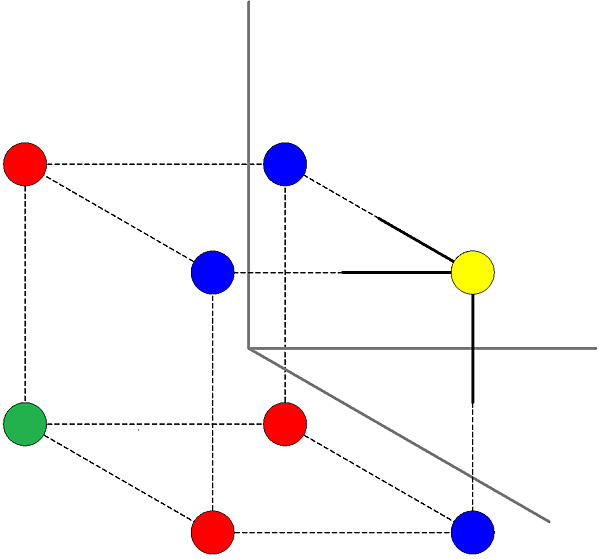
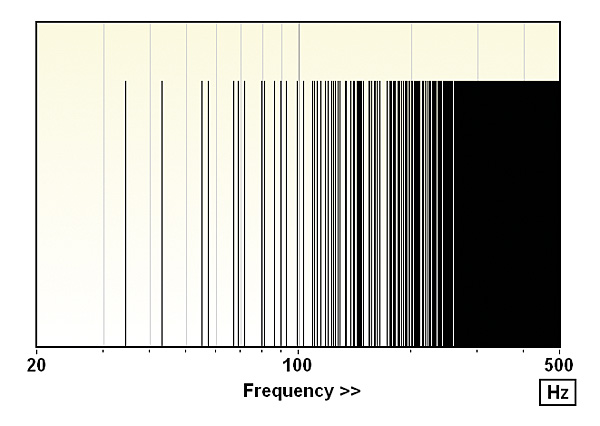
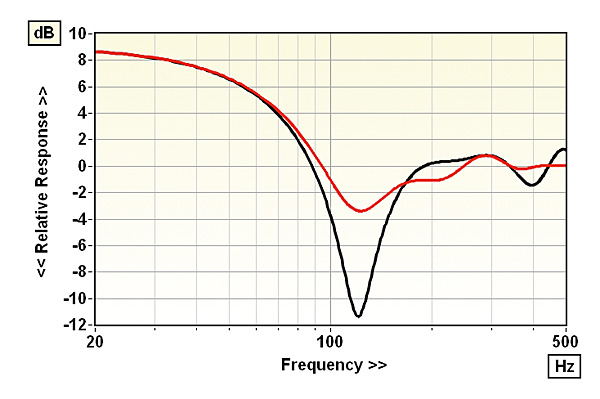
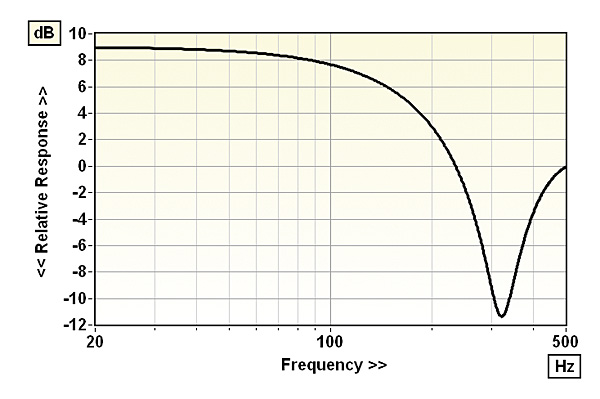
It has been suggested that the Schroeder frequency in fact significantly underestimates the frequency at which room modes cease to be individually perceived. Whether or not this is the case, it's clear that the modal behaviour of your listening room is not an issue affecting a subwoofer alone: the main speakers are subject to it too and it will have played a significant part in your deciding where to place them (assuming this was done with an ear to sound quality rather than an eye to practicable room layout).
One of the great advantages of a subwoofer is that it can be placed with sole consideration to bass quality, whereas with the main speakers a compromise often has to be reached between various aspects of overall performance.
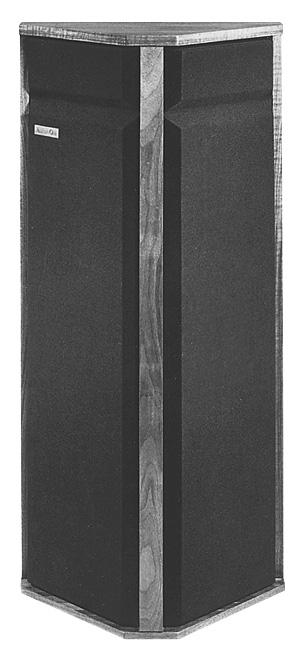 Boundary Gain
Boundary Gain
Boundary gain occurs because the boundaries of a room act, more or less, as acoustic mirrors. Just as when you look in a bathroom mirror a virtual you stares back from a distance behind the mirror the same as you are in front of it, likewise with room boundaries and sound. If we consider a single wall with a loudspeaker at a distance x in front of it, the combination will behave as if there were no wall there but instead a second speaker positioned at 2x distance from the first.
At low frequencies – sufficiently low that the spacing between the real and virtual speaker is negligible compared to the wavelength of sound in air (which is about 17m at 20Hz) – the two radiate almost in phase, with the result that power output and sound pressure both double (+3dB and +6dB respectively). At higher frequencies, as the spacing of the real and virtual speakers becomes significant relative to wavelength, their phase relationship varies so that at some frequencies their output adds, while at others it subtracts – and so the frequency response becomes uneven.
More Troublesome
If we consider a corner comprising three large boundaries mutually at right angles [see Fig 1] the situation becomes more complex. Now there are seven virtual loudspeakers, making eight in total including the real speaker. As a result the boundary gain at very low frequency results in eight-fold increases in radiated power and sound pressure (+9dB and +18dB respectively), and the behaviour at higher frequencies can be much more troublesome.
If, in the worst case, the sound source is equidistant from all three boundaries then the resulting power response looks like the black trace in Fig 3 (spacing here 0.8m), with a horrendous 11.4dB cancellation notch at a frequency where the source-boundary spacing is equal to 0.28 of the wavelength (here 121Hz). When the three boundary spacings are sufficiently different the power response is significantly improved (red trace in Fig 3, spacings here 0.6m, 0.8m, 1m), the dip in this instance reducing to 3.4dB at 123Hz.
As Roy Allison appreciated when he first investigated this effect on loudspeakers in the early 1970s, the way to overcome the problem of uneven output – and still exploit the available boundary gain to reduce driver excursion requirement – is to place the sound source close to at least two room boundaries and preferably three. If we reduce the three boundary spacings to 0.3m – ie, use a compact subwoofer tight in the corner – the resulting power response is as shown in Fig 4. The 11.4dB notch frequency is moved up to 322Hz so that the power output 20Hz to 80Hz – subwoofer territory – is now flat to ±0.4dB.

























































